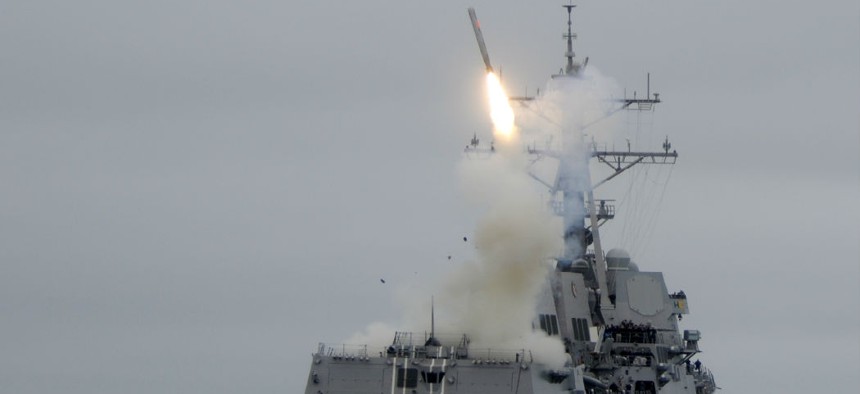Navy pushes deployment of seeker-enabled Tomahawk
Active seeker technology on the Navy’s Tomahawk missile will better enable the weapon to destroy moving targets at sea.
The Navy is accelerating deployment of an upgraded Maritime Strike Tomahawk missile designed to better enable the weapon to destroy moving targets at sea, service officials said.
The missile, which has been in development by Raytheon for several years, draws upon new software, computer processing and active-seeker technology, which sends an electromagnetic ping forward from the weapon itself as a method of tracking and attacking moving targets. The electronic signals bounce off a target, and then the return signal is analyzed to determine the shape, size, speed and contours of the enemy target. This technology allows for additional high-speed guidance and targeting.
The Navy’s acquisition executive recently signed rapid deployment paperwork for the weapon, clearing the way for prompt production and delivery, an industry source said.
“The seeker suite will enable the weapon to be able to engage moving targets in a heavily defended area,” Navy spokeswoman Lt. Kara Yingling told Defense Systems. “The Maritime Strike Tomahawk enables the surface fleet to seek out and destroy moving enemy platforms at sea or on land beyond their ability to strike us, while retaining the capability to conduct long range strikes,” she said.
The active seeker technology is designed to complement the Tomahawk’s synthetic guidance mode, which uses a high-throughput radio signal to update the missile in flight, giving it new target information as a maritime or land target moves, Raytheon’s Tomahawk Program Manager Chris Sprinkle said in an interview with Defense Systems.
The idea is to engineer several modes wherein the Tomahawk can be retargeted in flight to destroy moving targets in the event of unforeseen contingencies. This might include a scenario where satellite signals or GPS technology is compromised by an enemy attack. In such a case, the missile will still need to have the targeting and navigational technology to reach a moving target, Sprinkle added.
An active seeker will function alongside existing Tomahawk targeting and navigation technologies such as infrared guidance, radio frequency targeting and GPS systems.
“There is tremendous value to operational commanders to add layered offensive capability to the surface force. Whether acting independently, as part of a surface action group, or integrated into a carrier strike group or expeditionary strike group, our surface combatants will markedly upgrade our Navy's offensive punching power,” Yingling said.
Rapid deployment of the maritime Tomahawk is part of an ongoing Navy initiative to increase capability and capacity in surface combatants by loading every vertical launch system cell with multimission-capable weapons, Yingling explained.
Tomahawks have been upgraded several times over their years of service. The Block IV Tomahawk, in service since 2004, includes a two-way data link for in-flight retargeting, terrain navigation, digital scene-matching cameras and a high-grade inertial navigation system, Raytheon officials said.
The current Tomahawk is built with a “loiter” ability allowing it to hover near a target until there is an optimal time to strike. As part of this technology, the missile uses a two-way data link and camera to send back images of a target to a command center before it strikes.
The weapon is also capable of performing battle damage assessment missions by relaying images through a data link as well, Raytheon said.
The Navy is currently wrapping up the procurement cycle for the Block IV Tactical Tomahawk missile. In 2019, the service will conduct a recertification and modernization program for the missiles reaching the end of their initial 15-year service period, which will upgrade or replace those internal components required to return them to the fleet for the second 15 years of their 30-year planned service life, Yingling said.
“Every time we go against anyone that has a significant threat, the first weapon is always Tomahawk,” Sprinkle said. “ It is designed specifically to beat modern and emerging integrated air defenses.”
NEXT STORY: DOD CIO: Recent GAO criticism of JIE is off base





